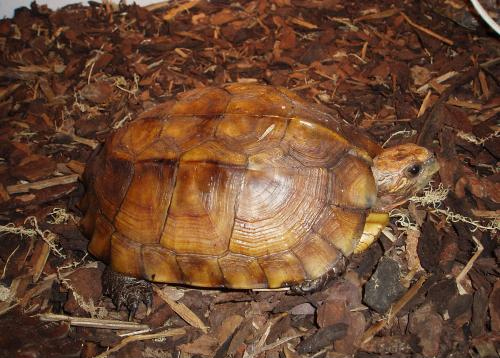 In Part 1 of this article we looked at the natural history of the interesting but little-studied Keeled Box Turtle (also known as the Jagged-shelled or Indian Thorn Turtle, Pyxidea mouhotii). Like many other turtles native to South and Southeast Asia, it is severely threatened by habitat loss and collection for the food trade, and would benefit from increased attention to captive reproduction.
In Part 1 of this article we looked at the natural history of the interesting but little-studied Keeled Box Turtle (also known as the Jagged-shelled or Indian Thorn Turtle, Pyxidea mouhotii). Like many other turtles native to South and Southeast Asia, it is severely threatened by habitat loss and collection for the food trade, and would benefit from increased attention to captive reproduction.
Keeping Keeled Box Turtles
Although little is known of their natural history, Keeled Box Turtles adjust well to captivity and soon lose their innate shyness. A pair I received as adults 20 years ago are still alive and well today at the Staten Island Zoo.
Keeled Box Turtles differ from most of their relatives in being largely nocturnal. They spend much of the day buried below leaves or soil, and rarely bask. Captives often abandon their nocturnal ways and forage by day. Night viewing bulbs are a useful means of providing nighttime heat and observation opportunities.
Reproduction
Little has been published on reproduction in the wild. In common with many turtles, male Keeled Box Turtles become quite aggressive during the breeding season. While a certain amount of neck-biting is typical during courtship for many species, male Keeled Box Turtles seem to carry this to extremes – in the close confines of captivity, they may seriously injure females if not monitored closely.
A typical clutch contains 1-5 eggs, which hatch after an incubation period of 97-108 days at a temperature of 82F. The carapace of the hatchlings, attractively marked in dark brown with a bright orange rim, is 1.4-1.6 inches long.
Diet
Keeled Box Turtles are reported to feed upon plants and fruits in the wild, but, judging from observations of captive animals, they likely consume carrion, insects, snails and other invertebrates as well.
Mine have thrived on a diet comprised of a wide variety of vegetables and fruits, crickets, earthworms, mealworms, pink mice and commercial turtle chow.
Further Reading
Please see this article to learn about the CUC Phoung Center’s efforts to rescue this and other Southeast Asian turtles.
Keeled Box Turtle image referenced from wikipedia and originally posted by Torsten Blanck
 That Reptile Blog – Reptile, Amphibian and Exotic Pet Care and Information
That Reptile Blog – Reptile, Amphibian and Exotic Pet Care and Information



Hi! I recently rescued a severely injured tortoise who ate boiled chicken for while but has stopped eating for almost three days now. I was hoping to keep it until the crack in its shell healed and leave it back into the wild there after… what should I do since it hasn’t been eating chicken? What other options should I explore?
Thanks!
Hello,
Diet depends upon the species; this varies greatly but most true tortoises are entirely herbivorous, or nearly so. Proper temperature, humidity and UVB light exposure is also critical; their care is quite complicated. A more pressing concern, however, is any bacterial/fungal infection that may be associated with the shell injury…shells can heal (usually very slowly) but infections can rapidly weaken and kill the animal w/o medication and proper care. My best advice, would be for you to locate an experienced veterinarian or a local turtle/tortoise club, if either is available, and ask for assistance in identifying the species and getting medical attention if needed. Please let me know if you need help in locating either.
Best, Frank
Can you tell me if this turtle can hibernate outside in the Winter months in New York. Thank you.
Hello Terry,
No, they cannot winter outdoors. It is a tropical species, and does not experience a cool season in the wild. Please let me know if you need further info, best, frank
Hey I have the pleasure if geting a cb keeled hatchling. I’m very excited. Can I setup like a normal north american type box of terrapine carolina. Ty dave
Hi Dave,
Nice to hear..they are not common. Set up similar – they like a thick substrate of leaves, wood chips etc; warmer temps than NA species tolerate – keep enclose at 72-80F, with a hot spot of 85-88F and ample UVB. Large water bowl, and keep humidity at 70% or higher via misting etc. Please keep me posted, Frank